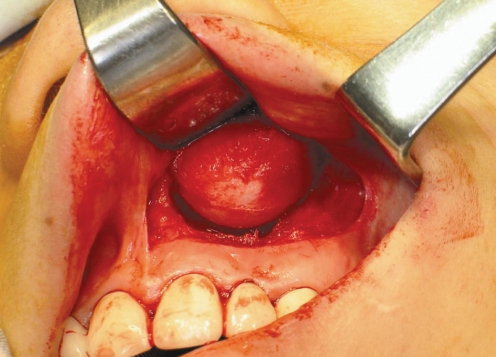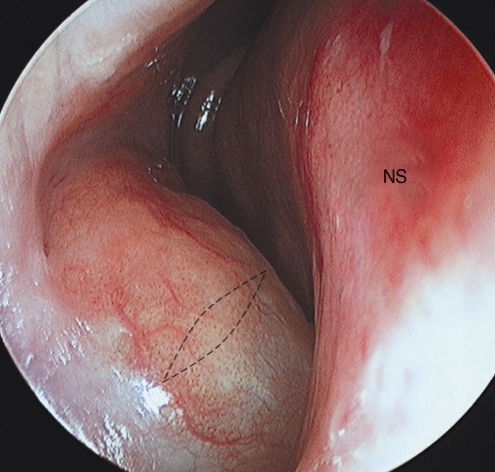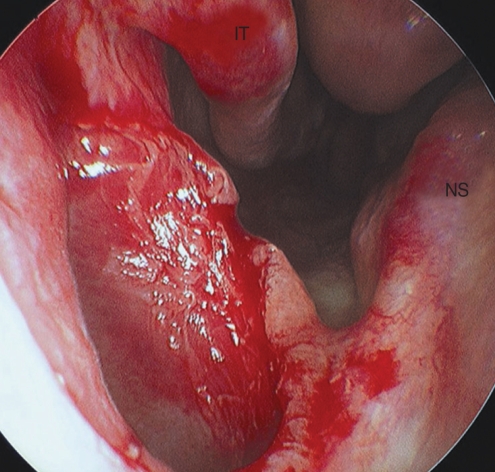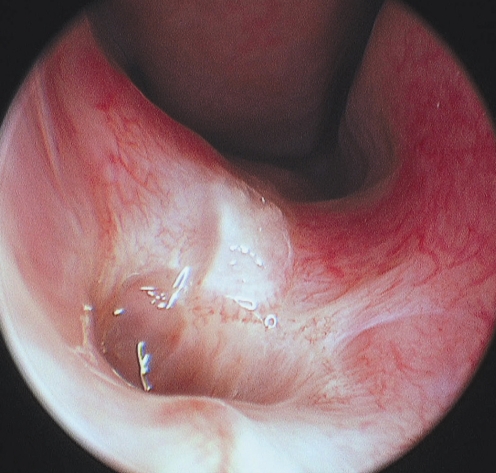Clin Exp Otorhinolaryngol.
2009 Jun;2(2):85-89. 10.3342/ceo.2009.2.2.85.
Comparison of Conventional Excision via a Sublabial Approach and Transnasal Marsupialization for the Treatment of Nasolabial Cysts: A Prospective Randomized Study
- Affiliations
-
- 1Department of Otorhinolaryngology-Head and Neck Surgery, Soonchunhyang University College of Medicine, Bucheon Hospital, Bucheon, Korea.
- 2Department of Otorhinolaryngology-Head and Neck Surgery, Soonchunhyang University College of Medicine, Cheonan Hospital, Cheonan, Korea. bjbaek@schca.ac.kr
- 3Department of Otorhinolaryngology-Head and Neck Surgery, Soonchunhyang University College of Medicine, Seoul Hospital, Seoul, Korea.
- KMID: 2007190
- DOI: http://doi.org/10.3342/ceo.2009.2.2.85
Abstract
OBJECTIVES
Surgical excision via a sublabial approach is considered the standard treatment for nasolabial cysts. Although transnasal marsupialization has been proposed as an alternative method, no prospective study has compared the effectiveness of these techniques. We thus compared the surgical procedure, operating time, postoperative pain, complications, and recurrence rate between the two surgical methods.
METHODS
Twenty patients diagnosed with nasolabial cysts were allocated randomly into two groups according to the surgical technique. In the sublabial approach group, the cysts were excised completely using a sublabial approach, while in the transnasal marsupialization group, the cysts were marsupialized transnasally under the guidance of nasal endoscopes. The pure operating time was measured and postoperative pain was evaluated using a visual analog scale. Complications after the procedure were assessed and recurrence was determined according to the clinical symptoms and postoperative radiologic findings.
RESULTS
The transnasal marsupialization group had significantly shorter operating times, less postoperative pain, lower complication rates, and shorter duration of side effects than the sublabial approach group. No recurrence occurred in either group after a 1-yr follow-up period.
CONCLUSION
Although both methods are effective for treating nasolabial cysts, the transnasal marsupialization of nasolabial cysts has many benefits over the conventional sublabial approach. Therefore, we propose that transnasal marsupialization be the treatment of choice for nasolabial cysts.
Keyword
Figure
Reference
-
1. Lopez-Rios F, Lassaletta-Atienza L, Domingo-Carrasco C, Martinez-Tello FJ. Nasolabial cyst: report of a case with extensive apocrine change. Oral Surg Oral Med Oral Pathol Oral Radiol Endod. 1997; 10. 84(4):404–406. PMID: 9347505.2. Ramos TC, Mesquita RA, Gomez RS, Castro WH. Transnasal approach to marsupialization of the nasolabial cyst: report of 2 cases. J Oral Maxillofac Surg. 2007; 6. 65(6):1241–1243. PMID: 17517314.
Article3. Choi JH, Cho JH, Kang HJ, Chae SW, Lee SH, Hwang SJ, et al. Nasolabial cyst: a retrospective analysis of 18 cases. Ear Nose Throat J. 2002; 2. 81(2):94–96. PMID: 11868481.
Article4. Su CY, Chien CY, Hwang CF. A new transnasal approach to endoscopic marsupialization of the nasolabial cyst. Laryngoscope. 1999; 7. 109(7 Pt 1):1116–1118. PMID: 10401852.
Article5. Yuen HW, Julian CY, Samuel CL. Nasolabial cysts: clinical features, diagnosis, and treatment. Br J Oral Maxillofac Surg. 2007; 6. 45(4):293–297. PMID: 17030357.
Article6. Vasconcelos RF, Souza PE, Mesquita RA. Retrospective analysis of 15 cases of nasolabial cyst. Quintessence Int. 1999; 9. 30(9):629–632. PMID: 10765869.7. David VC, O'Connell JE. Nasolabial cyst. Clin Otolaryngol Allied Sci. 1986; 2. 11(1):5–8. PMID: 3516463.
Article8. Chen CN, Su CY, Lin HC, Hwang CF. Microdebrider-assisted endoscopic marsupialization for the nasolabial cyst: comparisons between sublabial and transnasal approaches. Am J Rhinol Allergy. 2009; Mar–Apr. 23(2):232–236. PMID: 19401056.
Article9. Cohen MA, Hertzanu Y. Huge growth potential of the nasolabial cyst. Oral Surg Oral Med Oral Pathol. 1985; 5. 59(5):441–445. PMID: 3859802.
Article10. Allard RH. Nasolabial cyst. Review of the literature and report of 7 cases. Int J Oral Surg. 1982; 12. 11(6):351–359. PMID: 6820007.
- Full Text Links
- Actions
-
Cited
- CITED
-
- Close
- Share
- Similar articles
-
- Clinical Features and Treatment Results of 64 Cases of Nasolabial Cyst
- A Case of Bilateral Nasolabial Cysts
- A Case of Nasolabial Cyst After Orthognathic Surgery
- Long-Term Outcomes of Transnasal Endoscopic Marsupialization through Middle, Inferior Meatal Antrostomy or Extended Middle Meatal Antrostomy in Maxillary Sinus Mucoceles
- A Case of Huge Nasolabial Cyst in 56 Year-Old Patient





